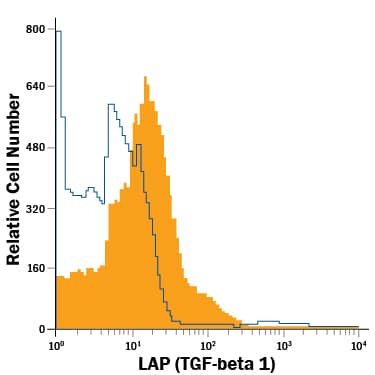Human LAP (TGF-beta 1) Alexa Fluor® 488-conjugated Antibody
R&D Systems, part of Bio-Techne | Catalog # FAB2463G


Key Product Details
Species Reactivity
Validated:
Cited:
Applications
Validated:
Cited:
Label
Antibody Source
Product Specifications
Immunogen
Leu30-Arg278 (Cys33Ser)
Accession # P01137
Specificity
Clonality
Host
Isotype
Scientific Data Images for Human LAP (TGF-beta 1) Alexa Fluor® 488-conjugated Antibody
Detection of LAP (TGF-beta 1) in Human Platelets by Flow Cytometry.
Human platelets were stained with Mouse Anti-Human LAP (TGF-beta 1) Alexa Fluor® 488-conjugated Monoclonal Antibody (Catalog # FAB2463G, filled histogram) or isotype control antibody (Catalog # IC002G, open histogram). View our protocol for Staining Membrane-associated Proteins.LAP (TGF-beta 1) in Human PBMCs.
LAP (TGF-beta 1) was detected in immersion fixed human peripheral blood mononuclear cells (PBMCs) stimulated with CD3/CD28/TGF-beta/IL-2 using Mouse Anti-Human LAP (TGF-beta 1) Alexa Fluor® 488‑conjugated Monoclonal Antibody (green; Catalog # FAB2463G) at 5 µg/mL for 3 hours at room temperature. Cells were counterstained with DAPI (blue). View our protocol for Fluorescent ICC Staining of Non-adherent Cells.Applications for Human LAP (TGF-beta 1) Alexa Fluor® 488-conjugated Antibody
Flow Cytometry
Sample: Human platelets
Immunocytochemistry
Sample:
Immersion fixed human peripheral blood mononuclear cells stimulated with CD3/CD28/TGF-beta/IL-2
Formulation, Preparation, and Storage
Purification
Formulation
Shipping
Stability & Storage
Background: LAP (TGF-beta 1)
TGF-beta 1 is one member of a six gene family that has been described in mammals, birds, fish and frog. The name TGF-beta is applied to a 24-28 kDa disulfide-linked dimer that is generated through the proteolytic processing of a larger precursor molecule. For TGF-beta 1, a 50-55 kDa, 391 amino acid (aa) proprecursor is first, covalently linked to a second proprecursor (creating a disulfide-linked homodimer), and second, internally cleaved to generate two covalently-linked homodimers that remain non-covalently associated. The smallest homodimer representing aa 279-390 of the proform is TGF-beta 1; the largest homodimer representing aa 30-278 of the proform is termed LAP (Latency-associated Peptide). The LAP homodimer wraps itself around the smaller TGF-beta 1 homodimer, thus blocking an interaction of mature TGF-beta with its receptors. Almost all cells secrete the inactive TGF-beta :LAP complex, and most do so with LAP covalently bound to a very large 120-160 kDa LTBP (Latent TGF-beta Binding Protein), platelets being a notable exception. LTBP associates with multiple matrix components and this serves to store TGF-beta extracellularly in a non-active form. When TGF-beta signaling is needed, the LTBP:matrix association is disrupted, and the TGF-beta :LAP complex is exposed to multiple LAP binding partners such as TSP-1 and various Integrins. Interactions with these factors cause LAP to unwrap and dissociate from TGF-beta, resulting in TGF-beta "activation" and receptor binding. Ther are three human TGF-beta 1 LAPs and TGF-beta 1 LAP shares 36% and 33% aa sequence indentity with TGF-beta 2 LAP and TGF-beta 3 LAP, respectively. Human to mouse, TGF-beta 1 LAP shares 86% aa sequence identity.
Long Name
Alternate Names
Entrez Gene IDs
Gene Symbol
UniProt
Additional LAP (TGF-beta 1) Products
Product Specific Notices for Human LAP (TGF-beta 1) Alexa Fluor® 488-conjugated Antibody
This product is provided under an agreement between Life Technologies Corporation and R&D Systems, Inc, and the manufacture, use, sale or import of this product is subject to one or more US patents and corresponding non-US equivalents, owned by Life Technologies Corporation and its affiliates. The purchase of this product conveys to the buyer the non-transferable right to use the purchased amount of the product and components of the product only in research conducted by the buyer (whether the buyer is an academic or for-profit entity). The sale of this product is expressly conditioned on the buyer not using the product or its components (1) in manufacturing; (2) to provide a service, information, or data to an unaffiliated third party for payment; (3) for therapeutic, diagnostic or prophylactic purposes; (4) to resell, sell, or otherwise transfer this product or its components to any third party, or for any other commercial purpose. Life Technologies Corporation will not assert a claim against the buyer of the infringement of the above patents based on the manufacture, use or sale of a commercial product developed in research by the buyer in which this product or its components was employed, provided that neither this product nor any of its components was used in the manufacture of such product. For information on purchasing a license to this product for purposes other than research, contact Life Technologies Corporation, Cell Analysis Business Unit, Business Development, 29851 Willow Creek Road, Eugene, OR 97402, Tel: (541) 465-8300. Fax: (541) 335-0354.
For research use only
